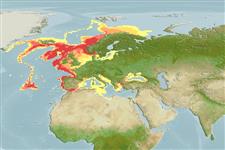Common names from other countries
Classification / Names / Names
Nomi Comuni | Sinonimi | Catalog of Fishes (gen., sp.) | ITIS | CoL | WoRMS
Environment: milieu / climate zone / depth range / distribution range
Ecologia
; distribuzione batimetrica 1 - 1829 m (Ref. 85345), usually 50 - 400 m (Ref. 125144). Subtropical; 72°N - 9°N, 19°W - 37°E
Northeast Atlantic, Eastern Central Atlantic and the Mediterranean.
Length at first maturity / Size / Peso / Age
Maturity: Lm ? range ? - ? cm
Depth based on occurrence (Ref. 2851, p. 719); to be replaced with better reference. Occurs in fine sand and silt substrate at depths between 50 to 200 m (Ref. 96391). Epibenthic (Ref. 87524) and free-living (Refs. 3123, 96391).
Life cycle and mating behavior
Maturità | Riproduzione | Deposizione | Uova | Fecundity | Larve
Members of the class Asteroidea exhibit both asexual (regeneration and clonal) and sexual (gonochoric) means of reproduction. Life cycle: Embryos hatch into planktonic larvae and later metamorphose into pentamorous juveniles which develop into young sea stars with stubby arms.
Alves, F., L. Chicharo, A. Nogueira and J. Regala. 2003. (Ref. 2851)
IUCN Red List Status (Ref. 130435)
CITES status (Ref. 108899)
Not Evaluated
Not Evaluated
Human uses
| FishSource |
Strumenti
Informazioni ulteriori
Age/SizeAccrescimentoLength-weightLength-lengthMorfologiaLarveAbbondanza
Fonti Internet
Estimates based on models
Preferred temperature
(Ref.
115969): 1.7 - 10.5, mean 7.1 (based on 112 cells).
Price category
Unknown.
